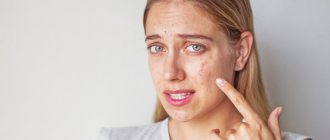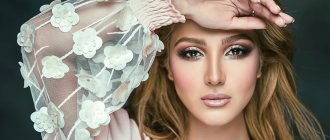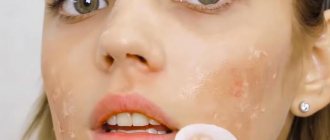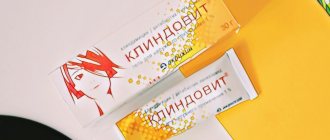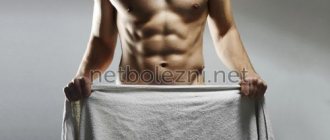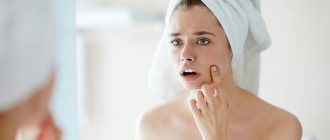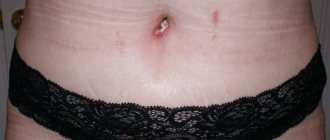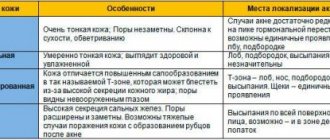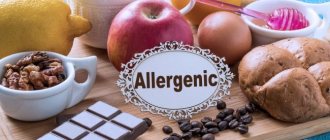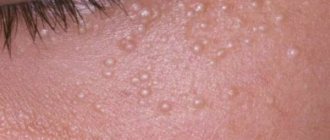Only 20 percent of schoolchildren can boast of healthy facial skin, the remaining 80 are forced to hide their hated acne behind long bangs and under a thick layer of foundation. How to get rid of acne? Let's talk to an expert.
Alim Khakuashev
Alim Khakuashev Dermatologist, cosmetologist, trichologist at the clinic for children and adolescents “SM-Doctor”
With the onset of adolescence, hormonal changes in the body begin. Testosterone is to blame for everything, the level of which affects the function of the sebaceous glands. During puberty, their function increases, resulting in acne. If a bacterial infection occurs, pustules will develop.
At 13-14 years old, black spots and red inflammation on the forehead and cheeks become the number one problem. The child looks at himself in the mirror with horror. No amount of persuasion and examples from stars (Cameron Diaz, Victoria Beckham, Rihanna) whose skin is far from ideal helps.
“Acne means endless ridicule from classmates,” says the mother of a 15-year-old son. — Clean facial skin helps you become more confident and overcome complexes. Unfortunately, there is no such miracle remedy that will get rid of acne once and for all. And dragging a teenager to a cosmetologist is also not easy. I really don’t know what to do.”
Mothers of girls on various forums also constantly discuss such topics. “How to cure these teenage acne? - asks Svetlana, mother of a 12-year-old daughter. — We already had ointments, tinctures, lotions, etc. in our arsenal. So far nothing has helped overcome this trouble. Grandmothers believe that in a couple of years everything will go away on its own, but I’m not sure.”
The cosmetologist warns that acne will not disappear on its own: “If you have facial skin imperfections, you need to contact a specialist as early as possible so as not to start the problem and take the necessary measures in a timely manner. Often, children and adolescents are embarrassed to see a doctor themselves or, due to their age, inadequately assess the severity of the disease. Therefore, parents should carefully monitor the condition of the child’s facial skin and, if necessary, immediately sound the alarm.”
Why does pimple inflammation* occur on the face?
One of the links in the pathogenesis of acne is an increase in the colonization of propionibacteria. Their reproduction is promoted by anaerobic conditions (clogged pores). Propionibacterium acnes during its life processes secrete substances that can attract neutrophilic leukocytes involved in inflammation. The body defends itself by producing antibodies in response - antigens of propionibacteria, which support the inflammatory process.10
Due to microbial antigens, neutrophil granulocytes and mononuclear phagocytes, which are part of the physiological protective system of cells, are attracted to the location of the rash. This contributes to the development of aseptic inflammation.10
Clindovit gel is a topical antibiotic. Its main active ingredient is clindamycin. It exhibits antimicrobial activity against propionibacteria.6
But it has long been proven that inflammation during acne formation is primary. Irritation of sebocytes (cells of the sebaceous glands) leads to the production of interleukins, which in turn are stimulators of inflammatory reactions. They provoke follicular hyperkeratosis, cause blockage of the sebaceous glands, resulting in the formation of comedones.40
Next, leukocytes 10 are attracted to the walls of the follicle. The vessels located around the inflamed area dilate, which causes swelling and redness. During the process of inflammation, cell destruction occurs and a cavity forms inside the papule. Over time, it fills with pus (a product of the breakdown of leukocytes and bacteria), transforming into a pustule 29.
Causes of formation of papular acne
The problem of papular acne mainly affects young people. In girls, this type of acne is usually more mild.
The changes that appear on the skin during the formation of papular acne are caused by the so-called hormonal storm. At a young age, hormone levels rise rapidly, causing the sebaceous glands to produce more sebum, which does not have time to be removed naturally.
Under physiological conditions, the production of sebum is necessary to create a protective layer on the skin that protects it from external factors. However, its excess, combined with exfoliating epidermis, sweat and dust from the environment, causes clogging of the sebaceous tubules and the appearance of acne, nodules and papules.
Bacteria multiply under the skin, and an inflammatory reaction develops, which is manifested by pain, pinpoint swelling and redness of the facial skin.
Papular acne in adults is caused by excessive stress, inadequate facial care, or problems with hormone (androgen) secretion. The most common problem of adult acne occurs in women, such as during menstruation or pregnancy. Papular changes are accompanied by pimples and acne.
How to relieve inflammation of a pimple* on the face?
You can relieve inflammation from a pimple* only if you use medications designed for this purpose. Many people make mistakes by using iodine and alcohol (including alcohol tinctures), but this only increases peeling of the skin, causing even greater blockage of the mouths of the follicles.
It would also be a mistake to use folk recipes, for example, applying soda masks to your face or wiping the skin with vinegar, so you will not only not be able to remove redness and inflammation, but will also create new ones.
In the treatment of acne, it is necessary to use drugs with keratolytic, antibacterial, anti-inflammatory, and sebum-regulating effects. Depending on the severity of the disease, topical, systemic drugs, or a combination of both may be prescribed.
Clindovit® gel is used to treat mild to moderate acne 6,18. It must be used 2-3 times a day 6.
A specialist must make a diagnosis and prescribe treatment. Non-drug methods can be used as auxiliary therapy, for example, laser therapy, mesotherapy, peelings, plasma therapy, etc. But they are contraindicated in active inflammatory processes. Only after the inflammation has been relieved can you resort to cosmetic procedures.
Inflamed acne: causes and treatment
A small and almost imperceptible pimple, when inflamed, turns into a huge problem: it increases in size, turns red and sometimes turns blue, hurts, itches, becomes hot to the touch and is practically impossible to disguise. Especially a lot of trouble is caused by formations on the face, since they are difficult to hide, as well as inflamed acne on the back - after all, even getting rid of the itching in this place is not easy.
Causes and triggers of acne inflammation
Inflammation of a subcutaneous or intradermal formation is the result of blockage of the hair follicle channel and sebaceous gland ducts by dead cells. Under such conditions, fat cannot come out freely and, accumulating, creates a favorable environment for the proliferation of bacteria and microbes. The process begins with redness, tenderness and swelling, then the contents either move closer to the upper layers of the skin, forming a white or yellowish top, or go into the inner layers to then appear elsewhere.
Inflamed acne occurs on the face and other parts of the body for the following reasons:
- absence, insufficiency or improper implementation of hygiene procedures;
- severe hypothermia, disrupting blood flow in the frostbitten area;
- hormonal crises, insufficient immunity, stress and poor nutrition;
- improperly performed cosmetic procedures, in particular mechanical facial cleansing.
Also, the inflammatory process can be provoked by attempts to squeeze out a pimple on your own - in inappropriate conditions and with a violation of technique.
How to deal with the problem?
On your own, you can treat only single small papules - pimples that form within the epidermis. Regular iodine is suitable for these purposes; you can also make masks with honey, white clay or aloe juice, wash the problem area with chamomile decoction or wipe with calendula tincture.
However, if inflamed acne or pimples appear regularly or several at a time, you should consult a doctor, since they can act as symptoms of serious diseases - meningitis, syphilis and others.
All other formations should under no circumstances become the object of amateur self-medication: their manifestation is a direct reason for an urgent visit to a specialist.
Medical offers effective assistance
Our clinic provides comprehensive treatment for inflamed acne of any etiology, located on any part of the body - face and neck, back and arms, abdomen, buttocks, pubis, inner thighs or genitals.
To begin with, our highly qualified cosmetologists, dermatologists, endocrinologists and other specialists conduct a full examination, which may include:
- blood tests - general, hormones and biochemistry;
- a coprogram that allows, based on the composition of feces, to analyze the intestinal microflora;
- examination of the condition of internal organs;
- scrapings and cultures from problem areas.
This allows us to accurately determine the cause of the appearance and inflammation of acne, so that we can then select an effective treatment strategy for the patient.
If there are inflamed acne elements on your skin, contact our medical office. The appointment is conducted by a highly competent dermatovenerologist and cosmetologist Valeria Borisovna Yamshchikova, who has in-depth knowledge and provides high-quality treatment to patients. Registration is carried out by telephone at a time convenient for the patient.
You can make an appointment with a doctor by calling
+7+7 (495) 980-13-16
How to remove inflammation after squeezing pimples*?
Everyone knows that acne should not be squeezed, but many people neglect this recommendation. If the follicle ruptures as a result of removing a pimple*, bacterial waste products enter the deep layers of the skin, causing irritation and damaging surrounding tissue10.
It is not possible to quickly remove an inflamed pimple*, since acne is a chronic disease, the treatment of which can take months18. A wound forms in place of the squeezed out acne element. You can apply an ice cube to it, the cold helps to narrow the pores and reduce swelling. Remember that dirt, dust, and infection easily penetrate into an open wound. Try not to touch this area with your hands, do not try to hide it with cosmetics and do not forget to cleanse your skin twice a day.
*elements of acne
Why do acne appear?
Acne is a serious skin disease that can occur with varying degrees of severity. The following can lead to the development of acne:
- Hormonal changes in the body.
- Poor nutrition (consumption of dairy products, sweets, soda, fast food), as well as taking certain medications. By the way, various steroid drugs, which athletes who visit gyms especially like to take, are dangerous. Muscles will appear along with acne on the face.
- Incorrectly selected care products and external therapy (a number of creams contain substances that can worsen rashes).
- Genetic predisposition plays a big role in the occurrence of acne. It has been proven that if one of the parents suffered from acne, then the child may also develop acne. And if both parents had this disease, then the child is much more likely to also have complexes due to acne.
- Stress associated with passing exams, unrequited love, etc., have a negative impact on the condition of the skin.
- Self-squeezing pimples further aggravates the skin condition. A teenager’s desire to solve problems in such a radical way can lead to irreversible consequences. This is primarily due to the structural features of the pustules. By getting rid of one, you will only contribute to the spread of infection into the deeper layers of the skin, and more pronounced inflammation and even more pimples will most likely appear in this place.
- “Irrational treatment and self-medication can lead to deterioration of the skin condition,” warns the doctor. - Progression of the disease, as well as serious complications, including the appearance of marks (scars) on the facial skin, which the child will then have to live with. Therefore, in case of such problems, you should definitely consult a doctor for an individual selection of treatment.”
Important! Overly clean children also suffer from acne. Often, teenagers, in the fight against acne, begin to fanatically wash their faces and wipe their skin with various lotions. But they usually contain alcohol, which dries the skin and causes active work of the sebaceous glands.
Treatment: collecting a set
Moving directly to the selection of products for acne and pimples from the pharmacy assortment, we will highlight several groups among them that can be combined with each other. Such complexes will increase the amount of the check, but will most likely be more effective than individual drugs.
Antibacterial agents. Drugs in this group can have a systemic effect (prescribed by a doctor - for example, doxycycline, clindamycin and erythromycin) and a local effect (in the form of gels and creams that contain clindamycin or erythromycin with zinc acetate).
Hygienic skin care. The arsenal of cleansers for acne on the face (tonics, scrubs, lotions, facial washes) will differ depending on skin type. You can also use herbal decoctions (chamomile, string, sage, coltsfoot, oak bark, celandine) as skin care products. It makes sense to use them for wiping the face and washing.
Vitamin and mineral complexes. These should include retinol, riboflavin, as well as ascorbic and folic acids.
Sorbents. These drugs remove toxins from the body, normalize intestinal function and support its microflora. Examples of such acne remedies are available in every pharmacy: activated carbon, dioctahedral smectite, polymethylsiloxane polyhydrate, colloidal silicon dioxide and hydrolytic lignin.
Probiotics. They will help restore the intestinal biocenosis. The best probiotics include lactulose, bifidobacteria longum and bifidum, enterococcus fecium, as well as lactobacillus acidophilus and kefir fungi.
Development mechanism
The development of acne is promoted by a huge number of factors, which can be divided into several groups.
Physiological factors:
- The proliferation of acne-causing bacteria is Propionibacterium acnes. The contents of the sebaceous glands with keratinized epithelium serve as a suitable environment for this.
- Hormonal disorders. This is why acne often appears during hormonal changes in the body (adolescence, premenstrual period, pregnancy, abortion). Increased levels of the male sex hormone, testosterone, also contribute to the appearance of acne. Therefore, acne often develops with hyperandrogenism.
- Diseases of the digestive system. More than half of the cases of acne are associated with the presence of chronic diseases of the stomach and intestines, especially with a violation of the intestinal biocenosis.
- Increased production of sebaceous glands. Increased production of sebum leads to its thickening and weakening of its bactericidal properties. As a result, blockage of the excretory ducts occurs.
- Hyperkeratosis is increased keratinization of skin cells. Dead cells further clog the ducts of the sebaceous glands.
- Disturbances of the microbial flora of the skin.
- Hereditary predisposition.
- Immune disorders.
- Chronic foci of infection.
Lifestyle factors:
- A state of prolonged stress.
- Nutrition. The appearance of acne is promoted by a diet with a predominance of carbohydrate foods, seasonings and spices.
- Long-term use of cosmetics that clog the pores of the sebaceous glands: powder, foundation, blush and fatty creams.
- Violation of personal hygiene rules - insufficient cleansing of the skin and squeezing out blackheads.
Other factors:
- Prolonged contact with toxic and polluting substances.
- Taking certain medications (for example, glucocorticoid hormones).
- Humid and hot climate.
Acne medications
Acne, pimples on the face and body, is a very unpleasant disease that brings a lot of discomfort, provokes the development of complexes, and requires long-term and, in some cases, expensive treatment. What effective anti-acne medications does modern pharmacology offer us?
Retinoids
Among the most popular retinoid drugs is Roaccutane, an anti-acne medicine that normalizes the functioning of the sweat glands. The drug helps to narrow the sebaceous glands and limit the amount of sebum produced. Retinoids have a fairly long list of contraindications and side effects, so you can take such drugs only with a prescription from a specialist.
Antibacterial drugs
In some cases, to effectively treat acne, doctors prescribe antibacterial drugs:
- Doxycycline,
- Levomycetin,
- Metronidazole,
- Tetracycline,
- Erythromycin.
Hormonal agents
Hormonal medications are effective if a woman’s acne is the result of an excess of male sex hormones in the body (this pathological condition is called hyperandrogenism). We are talking about modern oral contraceptives, which, in addition to their main task of preventing unwanted pregnancy, tidy up the skin.
Among the most popular hormonal drugs:
- Jess,
- Diana,
- Janine,
- Midiana,
- Yarina.
The above medications can only be taken as prescribed by a doctor, since self-treatment with hormonal drugs can lead to serious complications. It is important to understand that such drugs are not cures for acne, but drugs that can only indirectly affect the cause of acne.
Preparations for cleansing the body
Often the cause of acne on the body is toxins, waste, harmful substances that have accumulated in the body as a result of poor diet, smoking and alcohol abuse. In such cases, drugs are used to help cleanse the body:
- Activated carbon,
- Lactofiltrum,
- Polypephane,
- Filtrum STI.
Popular pharmacy products
The most effective acne medications that you can buy at the pharmacy:
- Baziron effectively destroys the bacterial infection that causes acne, and also promotes the renewal of damaged skin areas.
- Chatterbox is an anti-acne remedy that is prepared in a pharmacy according to a doctor’s prescription.
- Dalatsin gel contains the antibiotic clindamycin.
- Differin is effective in treating acne on oily skin.
- Zinerit contains an antibiotic, so there is no point in using it for a long time - the skin gets used to it and the effect of the product gradually disappears.
- Levomekol ointment is effective against acne and promotes the regeneration process of damaged skin.
- Metagyl gel.
- Skinoren gel has a pronounced anti-inflammatory effect.
- Chlorhexidine is an excellent remedy for cleansing and disinfecting problem skin.
- Effezel gel has an anti-inflammatory and antibacterial effect.
Ointments
Among the inexpensive and effective medications for acne on the face are ointments:
- Vishnevsky helps to “pull out” pus from acne, relieves inflammation, heals,
- Salicylic acid dries, relieves inflammation,
- Sulfur has a pronounced antimicrobial effect,
- Synthomycin heals and relieves pain,
- Streptocide dries and disinfects problem areas of the skin,
- Erythromycin is used in the treatment of acne and ulcers,
- Ichthyol destroys infection, promotes skin healing,
- Zinc perfectly dries the skin and controls sebum production.
Homeopathy
Homeopathic medicines for acne and acne are designed to combat the cause of their occurrence, and therefore require a fairly long-term use:
- Arnica,
- Gepar Sulfur,
- Mercurius Solubilis,
- Nux Vomika,
- Sulfur,
- Thuja.
The above medications are prescribed by a homeopathic physician individually for each patient.
Related products View all products
Adaklin, cream for external use
approx. 0.1% 30 g No. 1 635.00 RUR
More details
Azelik, gel for external use approx. 15% 30 g No. 1
698,00 ₽
More details
← Previous article Medicines for worms in children
Next article → Medicines for nausea
